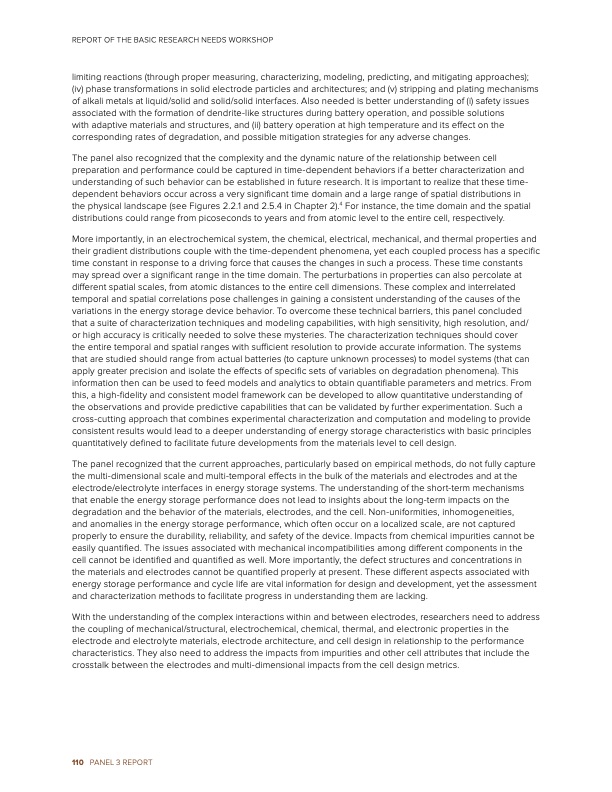
PDF Publication Title:
Text from PDF Page: 116
REPORT OF THE BASIC RESEARCH NEEDS WORKSHOP limiting reactions (through proper measuring, characterizing, modeling, predicting, and mitigating approaches); (iv) phase transformations in solid electrode particles and architectures; and (v) stripping and plating mechanisms of alkali metals at liquid/solid and solid/solid interfaces. Also needed is better understanding of (i) safety issues associated with the formation of dendrite-like structures during battery operation, and possible solutions with adaptive materials and structures, and (ii) battery operation at high temperature and its effect on the corresponding rates of degradation, and possible mitigation strategies for any adverse changes. The panel also recognized that the complexity and the dynamic nature of the relationship between cell preparation and performance could be captured in time-dependent behaviors if a better characterization and understanding of such behavior can be established in future research. It is important to realize that these time- dependent behaviors occur across a very significant time domain and a large range of spatial distributions in the physical landscape (see Figures 2.2.1 and 2.5.4 in Chapter 2).4 For instance, the time domain and the spatial distributions could range from picoseconds to years and from atomic level to the entire cell, respectively. More importantly, in an electrochemical system, the chemical, electrical, mechanical, and thermal properties and their gradient distributions couple with the time-dependent phenomena, yet each coupled process has a specific time constant in response to a driving force that causes the changes in such a process. These time constants may spread over a significant range in the time domain. The perturbations in properties can also percolate at different spatial scales, from atomic distances to the entire cell dimensions. These complex and interrelated temporal and spatial correlations pose challenges in gaining a consistent understanding of the causes of the variations in the energy storage device behavior. To overcome these technical barriers, this panel concluded that a suite of characterization techniques and modeling capabilities, with high sensitivity, high resolution, and/ or high accuracy is critically needed to solve these mysteries. The characterization techniques should cover the entire temporal and spatial ranges with sufficient resolution to provide accurate information. The systems that are studied should range from actual batteries (to capture unknown processes) to model systems (that can apply greater precision and isolate the effects of specific sets of variables on degradation phenomena). This information then can be used to feed models and analytics to obtain quantifiable parameters and metrics. From this, a high-fidelity and consistent model framework can be developed to allow quantitative understanding of the observations and provide predictive capabilities that can be validated by further experimentation. Such a cross-cutting approach that combines experimental characterization and computation and modeling to provide consistent results would lead to a deeper understanding of energy storage characteristics with basic principles quantitatively defined to facilitate future developments from the materials level to cell design. The panel recognized that the current approaches, particularly based on empirical methods, do not fully capture the multi-dimensional scale and multi-temporal effects in the bulk of the materials and electrodes and at the electrode/electrolyte interfaces in energy storage systems. The understanding of the short-term mechanisms that enable the energy storage performance does not lead to insights about the long-term impacts on the degradation and the behavior of the materials, electrodes, and the cell. Non-uniformities, inhomogeneities, and anomalies in the energy storage performance, which often occur on a localized scale, are not captured properly to ensure the durability, reliability, and safety of the device. Impacts from chemical impurities cannot be easily quantified. The issues associated with mechanical incompatibilities among different components in the cell cannot be identified and quantified as well. More importantly, the defect structures and concentrations in the materials and electrodes cannot be quantified properly at present. These different aspects associated with energy storage performance and cycle life are vital information for design and development, yet the assessment and characterization methods to facilitate progress in understanding them are lacking. With the understanding of the complex interactions within and between electrodes, researchers need to address the coupling of mechanical/structural, electrochemical, chemical, thermal, and electronic properties in the electrode and electrolyte materials, electrode architecture, and cell design in relationship to the performance characteristics. They also need to address the impacts from impurities and other cell attributes that include the crosstalk between the electrodes and multi-dimensional impacts from the cell design metrics. 110 PANEL 3 REPORTPDF Image | Next Generation Electrical Energy Storage

PDF Search Title:
Next Generation Electrical Energy StorageOriginal File Name Searched:
BRN-NGEES_rpt-low-res.pdfDIY PDF Search: Google It | Yahoo | Bing
Sulfur Deposition on Carbon Nanofibers using Supercritical CO2 Sulfur Deposition on Carbon Nanofibers using Supercritical CO2. Gamma sulfur also known as mother of pearl sulfur and nacreous sulfur... More Info
CO2 Organic Rankine Cycle Experimenter Platform The supercritical CO2 phase change system is both a heat pump and organic rankine cycle which can be used for those purposes and as a supercritical extractor for advanced subcritical and supercritical extraction technology. Uses include producing nanoparticles, precious metal CO2 extraction, lithium battery recycling, and other applications... More Info
| CONTACT TEL: 608-238-6001 Email: greg@infinityturbine.com | RSS | AMP |